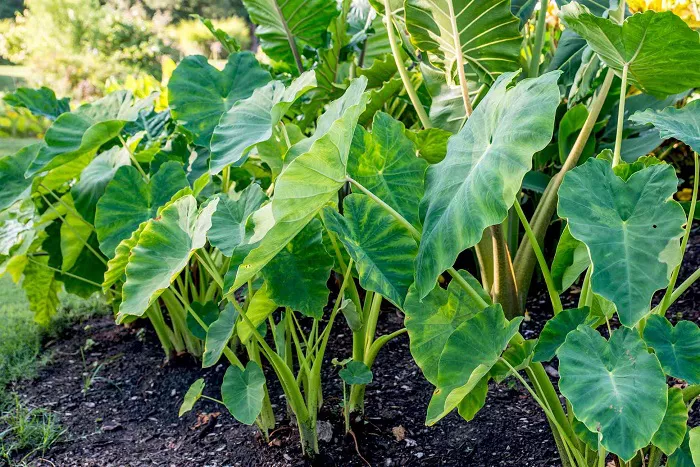Elephant ear plants, with their dramatic foliage and striking presence, are a favorite among garden enthusiasts. Their large, heart-shaped leaves can transform any garden or indoor space into a tropical paradise. But how long do these captivating plants take to grow? This article delves into the growth timeline of elephant ear plants, exploring factors that influence their development and offering tips for successful cultivation.
Understanding the Growth Cycle
From Dormant Bulbs to Sprouts
The journey of an elephant ear plant begins with its tuber, a dormant structure that holds the potential for lush growth. When planted in spring, typically after the last frost, these tubers start to awaken. The initial phase is slow, as the plant focuses on developing roots. Within two to three weeks, you may notice the first green shoots emerging from the soil. This stage is crucial, as it sets the foundation for the plant’s future health and size.
Leaf Development and Expansion
Once the sprouts appear, the growth accelerates. Elephant ear plants are known for their rapid leaf development. Within a month, the first set of leaves unfolds, and they continue to grow larger over the next few weeks. The leaves can reach impressive sizes, sometimes spanning several feet in width. During this period, the plant requires ample sunlight, water, and nutrients to support its vigorous growth. Regular watering and well-draining soil are essential to prevent root rot and ensure healthy leaf development.
Maturation and Peak Season
By midsummer, elephant ear plants reach their peak. The leaves are fully expanded, and the plant’s tropical appearance is at its finest. At this stage, the plant may also produce flowers, although flowering is not as common as leaf growth. The flowers, if they appear, are often inconspicuous and overshadowed by the large leaves. The plant’s height can vary depending on the variety, with some reaching up to six feet or more. Proper care, including regular fertilization and protection from pests, helps maintain the plant’s health and beauty throughout the season.
Factors Influencing Growth Time
Climate and Temperature
Elephant ear plants thrive in warm climates, typically in USDA hardiness zones 8 to 11. In these regions, the plants can grow outdoors year-round, with a growth period of about six to eight months from planting to full maturity. In cooler climates, however, the growth season is shorter, usually lasting from spring to fall. Temperature plays a significant role in the plant’s growth rate. Optimal daytime temperatures range from 70 to 85°F (21 to 29°C), while nighttime temperatures should not drop below 60°F (16°C). If temperatures fall below this range, the plant’s growth may slow or even cease.
Soil and Water Requirements
Rich, well-draining soil is essential for elephant ear plants. They prefer soil that is slightly acidic to neutral, with a pH between 6.0 and 7.0. Amending the soil with organic matter, such as compost or well-rotted manure, can improve its fertility and structure. Watering is another critical factor. These plants have high water needs, especially during the growing season. They should be watered deeply and regularly, allowing the soil to dry slightly between waterings. Overwatering can lead to root rot, while underwatering can cause the leaves to wilt and lose their vibrant color.
Light and Fertilization
Elephant ear plants thrive in partial to full sun, requiring at least four to six hours of sunlight per day. However, they can also tolerate some shade, especially in hot climates where intense afternoon sun may scorch the leaves. Fertilization is crucial for supporting the plant’s rapid growth. A balanced, slow-release fertilizer applied every four to six weeks during the growing season provides the necessary nutrients. Alternatively, a liquid fertilizer can be used, but it should be applied more frequently, following the manufacturer’s instructions.
Tips for Successful Cultivation
Planting and Spacing
When planting elephant ear tubers, choose a location with well-draining soil and adequate sunlight. Plant the tubers about 4 to 6 inches deep and 3 to 5 feet apart to allow for the plant’s large size. If planting in containers, ensure the pots have drainage holes and use a high-quality potting mix. Planting in groups can create a dramatic effect, but be mindful of the space each plant needs to grow.
Pruning and Maintenance
Regular maintenance helps keep elephant ear plants healthy and attractive. Prune any yellowing or damaged leaves to encourage new growth and prevent the spread of disease. Removing spent flowers, if they appear, can also help the plant focus its energy on leaf development. Keep an eye out for pests such as aphids or spider mites, which can infest the plants. Early detection and treatment with insecticidal soap or neem oil can prevent significant damage.
Overwintering and Storage
In regions where elephant ear plants are not hardy, overwintering the tubers is essential. Before the first frost, carefully dig up the tubers and remove any excess soil. Allow them to dry for a few days in a cool, dry place. Then, store the tubers in a breathable container, such as a mesh bag or a box filled with peat moss. Keep the container in a cool, dark location with temperatures between 50 to 60°F (10 to 16°C). Check the tubers periodically for signs of mold or rot and discard any damaged ones.
Conclusion
Growing elephant ear plants is a rewarding experience that brings a touch of the tropics to any garden. With proper care and attention to their needs, these plants can grow from dormant tubers to stunning, leafy specimens within a few months. Understanding their growth cycle and the factors that influence it allows gardeners to enjoy the beauty of elephant ear plants year after year. Whether planted outdoors or indoors, these plants are sure to make a statement with their dramatic foliage and unique presence.


